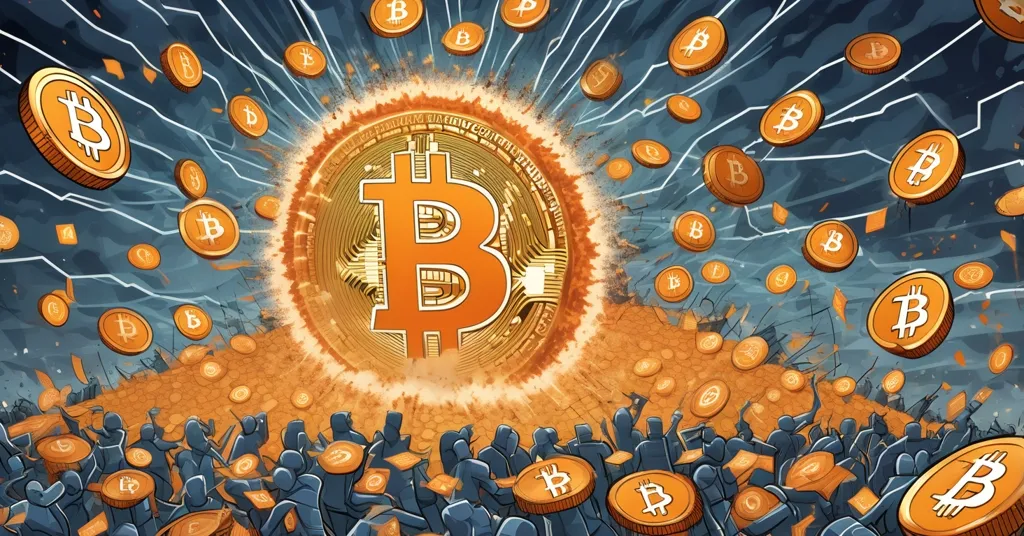Crypto Chaos 2025: Fed Drama, Trump Memecoin Bets, and Bitcoin’s Big Moves

Crypto at a Crossroads: Power Plays, Hype, and Hard Realities in 2025
The crypto world is a battleground of innovation, speculation, and regulatory reckonings as of July 12, 2025. From Federal Reserve chair Jerome Powell’s rumored exit shaking up traditional finance to Justin Sun’s $100 million Trump memecoin gamble, and global policy shifts pulling the industry in every direction, there’s no shortage of chaos—or opportunity. Let’s dissect the latest developments driving Bitcoin, blockchain, and decentralized tech, balancing the transformative potential with the gritty challenges ahead.
- Fed Firestorm: Jerome Powell’s potential resignation amid Trump’s attacks could ripple into crypto as a fiat hedge.
- Memecoin Madness: Justin Sun’s $100M Trump token bet fuels speculative bubbles tied to political hype.
- Global Tensions: Elon Musk boosts Bitcoin, while regulatory crackdowns and corporate pivots redraw the landscape.
This week’s crypto rollercoaster spans political power plays, wild gambles, and policy battles. Buckle up as we cut through the noise to spotlight what’s driving Bitcoin and beyond toward a future of financial freedom—or potential pitfalls.
Macro Shocks: Fed Drama and Political Uncertainty
At the heart of traditional finance, a storm is brewing that could send shockwaves into the crypto markets. Federal Reserve Chair Jerome Powell faces mounting speculation about a possible resignation, fueled by President Trump’s public disdain, calling him “terrible” for not slashing interest rates. Fannie Mae Chairman William Pulte has fanned the flames, stating:
“Encouraged by reports of Powell’s possible resignation, [it would help the economy] boom.”
The controversy doesn’t stop at policy disagreements—accusations of misleading Congress over a $2.5 billion Fed renovation project have piled on the pressure. While Powell has vowed to serve until at least 2026, and the Fed stays mum, the mere whisper of a shake-up at the top of centralized finance is enough to turn heads in the crypto space. If monetary policy wobbles or fiat uncertainty spikes, Bitcoin—already hovering near $110,000—stands to gain big from institutional inflows seeking a hedge. But let’s keep our feet on the ground; this is still unconfirmed speculation. A change in Fed leadership could just as easily tighten regulations on decentralized assets if the wrong replacement steps in. The dance between old money and new tech remains a high-stakes game, and we’re all watching the next move.
Speculative Frenzy: Justin Sun’s $100M Trump Memecoin Bet
On the wilder, weirder side of crypto, Tron founder Justin Sun is stirring the pot with a jaw-dropping $100 million investment in a Trump-themed memecoin, $TRUMP, just before a $474 million token unlock on the Tron blockchain. Sun, who’s no stranger to Trump-linked ventures, pitched this as a way to “grow the crypto landscape with communities such as GetTrumpMemes,” even dubbing $TRUMP the “currency of #MAGA.” The numbers tell a volatile tale—$TRUMP hit a $15 billion market cap at launch in January 2025, only to crater to $2 billion now, while a related $MELANIA token tanked 90% to under $141 million. With creators raking in $324 million in transaction fees from January to April, and 80% of $TRUMP controlled by the Trump Organization, this reeks of speculation on overdrive. Sun’s deeper ties to Trump ventures like World Liberty Financial—where 75% of profits reportedly flow to the family—only muddy the ethical waters. Let’s not sugarcoat it: this massive investment by Sun is a gamble blending political hype with crypto’s get-rich-quick underbelly. While memecoins can energize niche communities Bitcoin doesn’t reach, the risk of manipulation and outright scams is glaring. If politics and crypto had a lovechild, $TRUMP would be the screaming toddler—loud, messy, and hard to ignore.
Mainstream Momentum: Elon Musk’s Bitcoin Endorsement
Shifting to a more bullish beat, Elon Musk is throwing his considerable weight behind Bitcoin via his America Party platform, declaring, “Fiat is hopeless so yes,” when asked about supporting BTC. The impact? Bitcoin’s price edged close to $110,000, and Dogecoin jumped 6%. With Tesla holding over 11,500 BTC, Musk’s influence isn’t just hot air—it’s a market mover. This kind of mainstream validation from a tech titan turned political figure bolsters Bitcoin’s case as a store of value and a fiat alternative, especially against the backdrop of Fed uncertainty. Bitcoin maximalists are likely popping champagne, seeing this as a step toward mass adoption. But let’s flip the script—what if Musk’s endorsements are just noise, a billionaire’s puppet show distracting from Bitcoin’s core tech fundamentals? His track record shows pumps often lead to brutal dumps. Hype doesn’t equal stability, and while Elon’s tweets are crypto’s caffeine shot—great for a buzz, lousy for long-term health—we can’t ignore the short-term legitimacy he brings.
Corporate Play: Metaplanet’s BTC Bet and Bit Digital’s ETH Pivot
Corporate adoption of crypto is hitting fever pitch, starting with Japan’s Metaplanet emerging as a Bitcoin heavyweight. The company recently grabbed 2,205 BTC, bringing its stash to 15,555, and plans to use it as collateral for business acquisitions—think of it as using property to secure a loan, but with digital gold. CEO Simon Gerovich is relentless, saying, “We need to accumulate as much bitcoin as we can… to reach escape velocity,” eyeing a staggering 210,000 BTC by 2027. This isn’t just a treasury play; it signals Bitcoin morphing into a corporate financial tool, blurring lines between traditional business and decentralized tech. If Metaplanet pulls this off, it could inspire a wave of similar corporate Bitcoin strategies, cementing BTC’s role beyond speculative asset. The downside? Heavy accumulation risks overexposure if Bitcoin’s volatility strikes—hardly a small worry given past crashes.
Meanwhile, Nasdaq-listed Bit Digital is taking a different tack, selling 280 BTC to amass over 100,600 ETH, raising $172 million and spiking its stock 18%. This pivot reflects a bet on Ethereum’s smart contract ecosystem and staking yields—locking up tokens to secure the network and earn interest—over Bitcoin’s store-of-value narrative. Ethereum powers decentralized apps (dApps) and DeFi protocols, offering revenue streams BTC doesn’t touch. This move underscores a broader trend: while Bitcoin reigns as digital gold, altcoins like Ethereum carve out vital roles in decentralized finance and beyond. Critics might grumble this dilutes focus, but diversity in blockchain use cases fuels this revolution. Bitcoin can’t, and shouldn’t, do it all. For maximalists, though, Bitcoin’s unmatched censorship resistance still trumps ETH’s utility when privacy and freedom are the endgame.
Regulatory Realities: India’s Crackdown and Global Fragmentation
Regulatory shadows are darkening, especially in India, where the Financial Intelligence Unit (FIU) is probing Binance and WazirX over potential terror financing links via unhosted wallets—personal crypto storage not tied to centralized exchanges, making them harder to track. Activity flagged in Jammu & Kashmir includes Bitcoin use by Pakistan-based handlers for militant funding, while a 72-page affidavit details alleged ISIS-linked TRX token transfers tied to WazirX in Syria. Binance, already slapped with a $2.25 million fine for AML (anti-money laundering) violations in 2023, is cooperating, but the heat is on. An upcoming Singapore High Court hearing on WazirX user asset ownership adds legal bite. India’s crypto trading volume hit $1.9 billion in late 2024, and Pakistan boasts 15-20 million users, yet this boom clashes with national security fears as detailed in recent FIU investigations.
India’s regulatory flip-flops aren’t new—past near-bans and policy U-turns show a pattern of caution clashing with adoption. Outcomes could range from stricter KYC (know-your-customer) norms to outright restrictions, stalling growth in a key market unless compliance ramps up. The borderless nature of blockchain is a double-edged sword; it empowers financial freedom but draws heat for illicit use. South Asia’s massive user base could be a crypto powerhouse, but only if innovation balances with security.
Globally, policy fragmentation paints a chaotic picture. South Korea proposes venture status for crypto startups, a boost for innovation. Hong Kong’s stablecoin licensing race has over 40 applicants, including giants like JD.com and Circle. Conversely, New Zealand banned crypto ATMs over money laundering risks, while Trump Media filed for a Crypto Blue Chip ETF with the SEC, eyeing Crypto.com as custodian. Tether aims to be the largest Bitcoin miner by 2025. Some nations embrace crypto’s potential; others clamp down. This patchwork approach risks fracturing adoption unless a cohesive vision emerges. For a broader look at this week’s developments, check out the latest crypto news highlights.
Stablecoin Strength: Ripple’s RLUSD Breakthrough
On a steadier note, Ripple is carving a path with its RLUSD stablecoin, partnering with BNY Mellon for custody services and hitting a $500 million market cap in just seven months. Emily Portney of BNY Mellon noted, “We are thrilled to support the growth and adoption of RLUSD.” Stablecoins like RLUSD peg their value to assets like the US dollar, aiming for price stability unlike Bitcoin’s wild swings, making them ideal for everyday transactions and settlements. This is a win for Ripple CEO Brad Garlinghouse—whose net worth soared to $10 billion after a $50 million SEC settlement, a fraction of initial demands—and a sign stablecoins can bridge regulated finance and crypto. RLUSD is a middle finger to pure decentralization, but damn, it works for payments—a niche Bitcoin doesn’t aim to fill. Still, over-reliance on centralized custodians like BNY Mellon could clash with the ethos of privacy and freedom we champion, and stablecoins aren’t immune to regulatory heat.
Hype vs. Reality: TON Rumors and Tokenization Limits
Regulatory clarity, or the lack thereof, keeps biting. SEC Commissioner Hester Peirce, often called “Crypto Mom,” laid it out plain: tokenized securities are still securities, blockchain or not. She said:
“As powerful as blockchain technology is, it does not have magical abilities to transform the nature of the underlying asset.”
This cuts through hopes that tokenization—turning assets into digital tokens on a blockchain—might dodge existing laws, potentially chilling innovation unless legal pathways evolve. Meanwhile, the TON Foundation saw Toncoin jump 12% on false claims of a UAE Golden Visa for staking $100,000, only for UAE authorities to debunk it. This is classic crypto hype outpacing reality, showing why skepticism is as crucial as optimism. Misinformation spreads fast in this space, often fueled by a desperation for legitimacy or quick gains. It erodes trust, and investors must double-check claims before jumping in. These incidents, alongside heated discussions on platforms like Reddit about controversial crypto ventures, remind us that while blockchain’s potential is seismic, the road to mainstream adoption is littered with landmines of hype and half-truths.
Key Takeaways and Questions for Crypto Enthusiasts
- What could Jerome Powell’s potential resignation mean for Bitcoin markets in 2025?
A Fed leadership change might spike fiat uncertainty, driving Bitcoin inflows as a hedge, though tighter crypto regulations could counter gains. - Is Justin Sun’s $100 million Trump memecoin bet a game-changer or a risky stunt?
It’s a speculative stunt, amplifying memecoin volatility and political profiteering risks over sustainable crypto growth. - How does Elon Musk’s Bitcoin endorsement impact mainstream adoption?
It lifts visibility and price short-term, but lasting adoption hinges on Bitcoin’s fundamentals, not celebrity buzz. - What does Metaplanet’s Bitcoin accumulation signal for corporate strategies?
It shows Bitcoin becoming a treasury asset, though volatility risks loom large if markets turn sour. - Are regulatory crackdowns like India’s FIU probe a threat to crypto growth?
They’re a hurdle, not a death knell, pushing the need for compliance to balance innovation with security in booming markets. - Why does Ripple’s RLUSD success matter in the stablecoin race?
It proves stablecoins can earn institutional trust, complementing Bitcoin by filling practical payment niches. - Does Bit Digital’s Ethereum pivot challenge Bitcoin’s dominance?
Not directly—it highlights Ethereum’s unique DeFi and staking strengths, enriching the ecosystem alongside Bitcoin. - How do global policy differences shape crypto’s future?
Fragmented policies create uneven adoption; supportive regions fuel growth, while bans risk stifling local innovation.
Navigating this week’s whirlwind, it’s evident the crypto space stands at a pivotal juncture. Political dramas, corporate maneuvers, and regulatory chess games make the path to decentralization anything but smooth. Bitcoin remains the flagbearer of financial freedom, but altcoins, stablecoins, and even memecoins play their chaotic roles in this revolution. As champions of disruption and effective accelerationism, we see the raw potential for a seismic shift in how money and power operate—yet the pitfalls are glaring. With crypto caught between innovation and oversight, what’s the one barrier you think must fall first for true financial freedom to take root?



